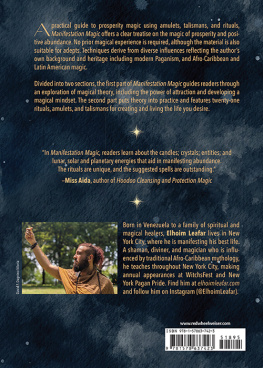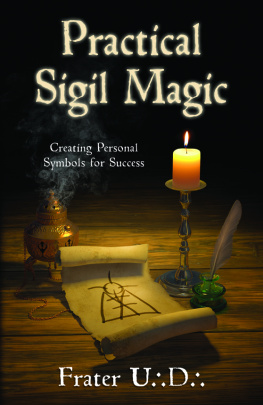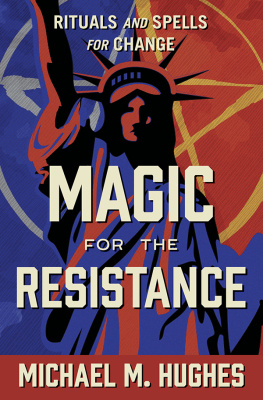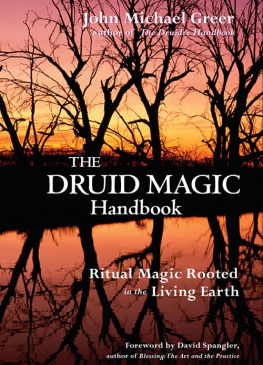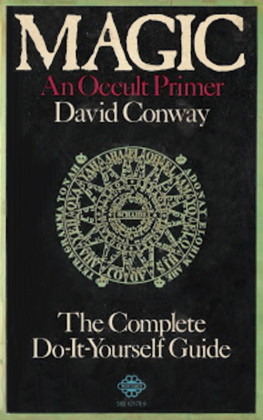Ritual Magic
for Conservative Christians
Brother A.D.A.
THAVMA Publications
Of necessity, this Kindle edition has differences in formatting from the paperback edition. All content is present and accounted for.
This book Copyright 2005-2016,
Brother ADA and THAVMA Publications
ISBN-10: 1523697067
ISBN-13: 978-1523697069
Website: http://thavmapub.com
Facebook pages: http://facebook.com/OccultCatholicism
Also on Facebook: http://www.facebook.com/ChristianOccultism
Unless otherwise stated, Scriptural quotes come from the New International Version , Copyright Biblica . 1978, 1984, 2011.
Quotes from the Apocrypha come from the New Revised Standard Version , Copyright Division of Christian Education of the National Council of the Churches of Christ in the USA. 1989.
Cover Image: The Crucifixion of Christ , Piero di Cosimo , circa 1510.
Independent authors rely greatly on reviews. Once youve read this book, please take a moment to review it on the site where you purchased it, to let others know how you feel.
Other Books from Brother A.D.A .
1. Is Magic Wrong?
2. The Magic of Catholicism
3. Ways of the Holy Benedetta
4. Christian Candle Magic
5. We Pray the Rosary
Brother A.D.A. ( Agostino Taumaturgo ) is available for classes, speaking engagements, and one-on-one magical coaching. He can be reached at .
TABLE OF CONTENTS
0. FOREWORD AND INTRODUCTION
Although a magician, I have always considered myself a theologian first and an occultist second. Those who know my work will know theology is the lens through which I view all magical subjects.
My approach to magic has never been one to rely on other peoples professed visions or special revelations, but the method of the theologian. That was the approach I took in The Magic of Catholicism , and now I hope to apply that approach across the denominational spectrum.
What you now have in your hands is a system of practical magic usable by any Christian from any mainstream denominational background, the result of 26 years of study and practice, the result of building a magical system from scratch with no concept that wasnt already in the Christian religion, a house whose bricks were all fired in the kiln of small-o orthodoxy.
With one major exception, every symbol can be traced to historic Christian usage, every color and gesture can be linked to Christian liturgy or popular piety, and every prayer is one that can be uttered by a believing Christian. When denominational differences pose an issue, I endeavor to state the issue clearly and concisely.
My friends, you hold in your hands a complete curriculum and a complete training program in orthodox Christian high magic. If you find that magic is for you, then do the exercises regularly and develop the inner discipline to persevere with the system. By your baptism you have already been initiated into one of the greatest magical orders in history. Now it is time to lay claim to that initiation and develop your gifts to their fullest potential.
Manifest with orthodoxy.
Believe with power.
Grow with awesomeness.
Pax vobis !
Brother A.D.A.
PRONUNCIATION OF LATIN
There are three major forms of Latin Pronunciation: Classical , taught in classrooms; Continental , most often heard in classical music recordings; and Italianate , used in Church services, horror movies, and most occasions one hears Latin. We give the Italianate, because its the most commonly heard and used.
VOWELS:
a as in fa ther
e as in they or me t
i as in machi ne
o as in alo ne
u as oo in moo n
y as i in machi ne
DIPTHONGS
ae like ey in they
oe like ey in they
au like ou in ou t
When a dieresis mark occurs, it means two vowels should be pronounced individually. For example, a should be pronounced ah-ay instead of ay.
Consonants are pronounced just like in English, with the exception of the following:
c before e, i , y, ae , or oe : like ch in ch air
ch always hard as in ach e
g before e, i , y, ae , or oe : like j in j ar (or su in treasu re)
h is silent
j like y in y es
sc before e, i , y, ae , or oe : like sh in sh all
th always like t in t alk
ti before vowels, like tsee
PRONUNCIATION OF GREEK
The pronunciation given here is Modern Greek, used in conversation as well as the liturgy of the Greek Orthodox Church.
LETTERS
, Alpha (a as in father)
, Beta (v as in victor)
, Gamma (g as in go)
(Before e, e, i , y, y as in year)
, Delta ( th as in that)
, Epsilon (e as in met)
, Zeta (z as in zebra)
, Eta ( i as in machine)
, Theta ( th as in theater)
, Iota ( i as in machine)
, Kapa (k as in keep)
, Lambda (l as in lake)
, Mi (m as in music)
, Ni (n as in new)
, Xi (x as in excellent)
, Omicron (o as in alone)
, Pi (p as in plastic)
, Rho (r as in rhyme)
, Sigma (s as in sail)
( written at the end of a word)
, Tav (t as in talk)
, Ypsilon ( i as in machine)
, Phi (f as in fun)
, Chi (guttural ch or h sound)
, Psi ( ps as in oops)
, Omega (o as in alone)
DIPTHONGS
( ey in they)
( i in machine)
( i in machine)
( i in machine)
( i in machine)
(like ov in mazzel tov )
(like ev in everlasting)
(like oo in moon)
CONSONANT GROUPS
( nd as in sandwich)
( beginning of word, d as in data)
( mb as in thimble)
( beginning of word, b as in boy)
( ng as in angle)
( beginning of word, g as in go)
( ng as in ankle)
( beginning of word, g as in go)
( dz as in adze)
When a dieresis mark occurs, it means two vowels should be pronounced individually. For example, should be pronounced ah- ee instead of ay.
PRONUNCIATION OF HEBREW
Hebrew is read from right to left, and each consonant has a numerical value.
There are two main forms of pronunciation, the Sephardi and the Ashkenazi . This chart reflects the latter, which is used by the author.
CONSONANTS WITH NUMERICAL VALUES
Alef (silent), 1
Ves (V), 2
Bes (B), 2
Gimel (G), 3
Gimel (G), 3
Dales (D), 4
Dales (D), 4
Heh (H), 5
Vav (V), 6
Vav (O), 6
Vav (U), 6
Zayin (Z), 7
Ches (CH, gutteral ), 8
Tes (T), 9
Yod (Y), 10
Khaf (CH, gutteral ), 20
Khaf (at the end of a word), 20
Kaf (K), 20
Lamed (L), 30
Mem (M), 40
Mem (at the end of a word), 40
Nun (N), 50
Nun (at the end of a word), 50
Samekh (S), 60
Ayin (silent), 70
Fe (F), 80
Fe (at the end of a word), 80
Pe (P), 80
Tsade (TS), 90
Tsade (at the end of a word), 90
Qof (K, Q), 100
Resh (R), 200
Shin (SH), 300
Sin (S), 300
Sav (S), 400
Tav (T), 400
VOWELS (Under consonants. Alef used as an example)
Patach (a in father)
Qamats (aw as in saw)
or Tsere ( ey as in they)
Segol (e as in met)
or Hiriq ( i as in machine)
or Holam (o as in alone)
Qubuts ( oo as in moon)
Mapiq ( oo as in moon)
Sheva (end of syllable or schwa)
Hataf Patach (quick a sound)
Hataf Qamats (quick aw)
Hataf Segol (quick "eh")
I. MAGIC: APPLIED THEOLOGY
Next page

